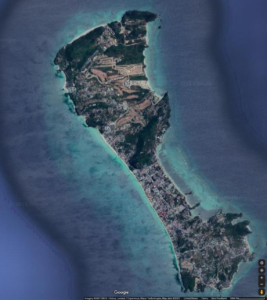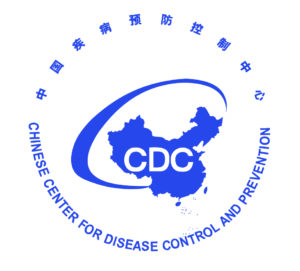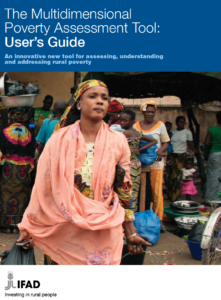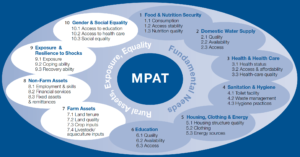Poverty, Water, Climate Change, & Health in Sub-Saharan Africa
Start Year: 2020 | End Year: Ongoing

As described below (see other project summaries), the Multidimensional Poverty Assessment Tool (MPAT) was created in two phases (from 2008 to 2014) via a collaborative, international initiative to develop, test, and pilot a new tool for local-level rural poverty assessment. The work was guided by a Sounding Board of experts from the International Fund for Agricultural Development (IFAD), other United Nations agencies, international and regional organizations, and universities around the world (see www.ifad.org/mpat). Following MPAT’s finalization and institutionalization in 2014, it was used in multiple countries including many in Sub-Saharan Africa. We are currently working on multiple desk-based studies with a variety of collaborators to analyze data from ~7,000 households across Eswatini, Kenya, Lesotho, Mali, Tanzania, and Zimbabwe. Because MPAT was developed based primarily on data from Bangladesh, China, India, and Mozambique, one study we are leading is an updated assessment and evaluation of MPAT’s indicator structure and robustness based on its use in the sub-Saharan region. Other studies we are working on focus on a cross-county analyses of MPAT’s water, climate change, and health focused components and sub-components, and related programs and interventions. We anticipate publishing a number of papers on this research in 2024.
Funding & Support
![]()


Wastewater & Coastal Environmental Health in the Philippines
Start Year: 2018 | End Year: 2022
 This research collaboration between colleagues at the University of California Berkeley (UCB) and the University of the Philippines (UPD) was designed to advance methods for measuring, modelling, and assessing marine water quality and environmental health at three sites in the Philippines. One of the three study sites for this multi-year project is Boracay Island. A popular tourist destination, in recent years sewage and other contaminants have adversely impacted Boracay’s beaches and coastal water quality, with implications for both environmental and human health. This research project centers on the use of an autonomous surface vessel to collect a wide range of spatially referenced data which can be combined with data from water samples and lab-based analyses, as well as satellite and other remote sensed data. At the Boracay site, proxy sensor data (e.g., optical brighteners and tryptophan) and laboratory analyses of grab samples will be combined to map and model actual and estimated water quality and environmental health impacts from point and non-point runoff and wastewater effluent. Our planned research activities and associated timelines suffered from a variety of logistical setbacks and delays, as well as delays related to the COVID-19 Pandemic. We anticipate publishing findings from this work starting in 2023.
This research collaboration between colleagues at the University of California Berkeley (UCB) and the University of the Philippines (UPD) was designed to advance methods for measuring, modelling, and assessing marine water quality and environmental health at three sites in the Philippines. One of the three study sites for this multi-year project is Boracay Island. A popular tourist destination, in recent years sewage and other contaminants have adversely impacted Boracay’s beaches and coastal water quality, with implications for both environmental and human health. This research project centers on the use of an autonomous surface vessel to collect a wide range of spatially referenced data which can be combined with data from water samples and lab-based analyses, as well as satellite and other remote sensed data. At the Boracay site, proxy sensor data (e.g., optical brighteners and tryptophan) and laboratory analyses of grab samples will be combined to map and model actual and estimated water quality and environmental health impacts from point and non-point runoff and wastewater effluent. Our planned research activities and associated timelines suffered from a variety of logistical setbacks and delays, as well as delays related to the COVID-19 Pandemic. We anticipate publishing findings from this work starting in 2023.
Funding & Support

Evaluating Household-level Drinking Water Treatment in Rural China
Start Year: 2012 | End Year: 2014
 After extensive discussion and planning, we started a collaborative research project with colleagues at the NCRWSTG and China CDC to characterize and assess methods of household water treatment (HWT) in low-income regions of rural China. During the first phase of this research, in the summer of 2013, we collected drinking water samples and administered surveys to 450 households across 15 rural villages in Guangxi province. To assess seasonal factors, we undertook a second round of data collection in the winter of 2013/2014 during which time we also affixed remote temperature sensors to kettles and pots to help corroborate reported boiling data. In 2014, under the supervision of China CDC colleagues Director Tao Yong and Dr. Qing Luo, we replicated the study in Henan province, collecting data from 450+ rural households during the summer. Using a variety of modeling approaches, we evaluated the microbiological effectiveness of the HWT methods used – including bottled water (large 19L bottles) – and isolated socioeconomic predictors associated with HWT and water-related beliefs and behaviors. Among other findings, we observed that indicators of fecal contamination were lowest in drinking water samples from households using electric kettles. Our analyses of boiling-associated air pollution indicated that switching from boiling with pots and solid fuels to boiling with electric kettles would result in a measurable reduction in indoor air pollution. We also observed relatively high rates of microbiological contamination in samples from households using bottled water; and our analyses of socioeconomic factors suggested that rural bottled water use will continue to increase in the future. Results from these studies – as well as a systematic review on boiling and health outcomes – were also used to support and inform the design of an intervention to promote the use of electric kettles in low-income rural communities (see project summary above).
After extensive discussion and planning, we started a collaborative research project with colleagues at the NCRWSTG and China CDC to characterize and assess methods of household water treatment (HWT) in low-income regions of rural China. During the first phase of this research, in the summer of 2013, we collected drinking water samples and administered surveys to 450 households across 15 rural villages in Guangxi province. To assess seasonal factors, we undertook a second round of data collection in the winter of 2013/2014 during which time we also affixed remote temperature sensors to kettles and pots to help corroborate reported boiling data. In 2014, under the supervision of China CDC colleagues Director Tao Yong and Dr. Qing Luo, we replicated the study in Henan province, collecting data from 450+ rural households during the summer. Using a variety of modeling approaches, we evaluated the microbiological effectiveness of the HWT methods used – including bottled water (large 19L bottles) – and isolated socioeconomic predictors associated with HWT and water-related beliefs and behaviors. Among other findings, we observed that indicators of fecal contamination were lowest in drinking water samples from households using electric kettles. Our analyses of boiling-associated air pollution indicated that switching from boiling with pots and solid fuels to boiling with electric kettles would result in a measurable reduction in indoor air pollution. We also observed relatively high rates of microbiological contamination in samples from households using bottled water; and our analyses of socioeconomic factors suggested that rural bottled water use will continue to increase in the future. Results from these studies – as well as a systematic review on boiling and health outcomes – were also used to support and inform the design of an intervention to promote the use of electric kettles in low-income rural communities (see project summary above).
Funding & Support




Refinement & Finalization of the Multidimensional Poverty Assessment Tool (MPAT)
Start Year: 2010 | End Year: 2014
 Following the release of the working-paper User’s Guide for the Multidimensional Poverty Assessment Tool (MPAT) in 2009, a number of agencies and universities used the beta-version of MPAT in a variety of settings. In order to finalize MPAT and develop a comprehensive User’s Guide and associated resources, we built on the lessons learned from early adopters of the the tool (e.g., an NGO in Kenya) and iteratively used and evaluated the tool with IFAD-supported projects in Bangladesh and Mozambique. Details on the participatory expert elicitation methods we used are provided in a Journal of Development Studies paper. We developed an Excel-based data entry platform so users could easily calculate MPAT’s indicators at household, village, and project levels. We also wrote a comprehensive, 300+ page, 2014 MPAT User’s Guide which provides step-by-step instructions for using MPAT as well as training modules and materials, all with the goal of making MPAT an accessible open-source tool. The User’s Guide and accompanying resources were presented at a 2014 launch event in Rome. Since its 2014 release, MPAT has been translated into a number of languages, an optional 11th component focused on climate change was added, and MPAT has been used by a variety of agencies and institutions around the world. MPAT publications and related resources are available at www.ifad.org/mpat.
Following the release of the working-paper User’s Guide for the Multidimensional Poverty Assessment Tool (MPAT) in 2009, a number of agencies and universities used the beta-version of MPAT in a variety of settings. In order to finalize MPAT and develop a comprehensive User’s Guide and associated resources, we built on the lessons learned from early adopters of the the tool (e.g., an NGO in Kenya) and iteratively used and evaluated the tool with IFAD-supported projects in Bangladesh and Mozambique. Details on the participatory expert elicitation methods we used are provided in a Journal of Development Studies paper. We developed an Excel-based data entry platform so users could easily calculate MPAT’s indicators at household, village, and project levels. We also wrote a comprehensive, 300+ page, 2014 MPAT User’s Guide which provides step-by-step instructions for using MPAT as well as training modules and materials, all with the goal of making MPAT an accessible open-source tool. The User’s Guide and accompanying resources were presented at a 2014 launch event in Rome. Since its 2014 release, MPAT has been translated into a number of languages, an optional 11th component focused on climate change was added, and MPAT has been used by a variety of agencies and institutions around the world. MPAT publications and related resources are available at www.ifad.org/mpat.
Funding & Support


Developing a Thematic Indicator for Rural Poverty Assessment (MPAT)
Start Year: 2008 | End Year: 2009
 The Multidimensional Poverty Assessment Project was a collaborative, international initiative to develop, test, and pilot a new tool for local-level rural poverty assessment. The work was supported by IFAD and guided by a Sounding Board of experts from IFAD, other United Nations agencies, international and regional organizations, and universities around the world, with the majority of its members coming from the Asia region where we developed and tested the tool in China and India. Surveys (household and village level) were developed and tested in an iterative and participatory fashion, as was the indicator structure used to aggregate sub-components and components. The resulting Multidimensional Poverty Assessment Tool (MPAT) provides an assessment, an overview, of ten dimensions central to rural livelihoods, highlighting where additional support or interventions are likely to be most needed. The tool was designed to be universal enough to be relevant to most rural contexts around the world, yet specific enough to provide project managers and others a detailed overview of key dimensions relevant to rural poverty reduction efforts. MPAT was independently evaluated by the European Commission Joint Research Center and a working-paper version of MPAT User’s Guide was released in 2009 as well as the 2009 MPAT Book, which provides a detailed description of why and how the tool was developed. MPAT’s theoretical foundations are described in a 2010 article in Development and Practice.
The Multidimensional Poverty Assessment Project was a collaborative, international initiative to develop, test, and pilot a new tool for local-level rural poverty assessment. The work was supported by IFAD and guided by a Sounding Board of experts from IFAD, other United Nations agencies, international and regional organizations, and universities around the world, with the majority of its members coming from the Asia region where we developed and tested the tool in China and India. Surveys (household and village level) were developed and tested in an iterative and participatory fashion, as was the indicator structure used to aggregate sub-components and components. The resulting Multidimensional Poverty Assessment Tool (MPAT) provides an assessment, an overview, of ten dimensions central to rural livelihoods, highlighting where additional support or interventions are likely to be most needed. The tool was designed to be universal enough to be relevant to most rural contexts around the world, yet specific enough to provide project managers and others a detailed overview of key dimensions relevant to rural poverty reduction efforts. MPAT was independently evaluated by the European Commission Joint Research Center and a working-paper version of MPAT User’s Guide was released in 2009 as well as the 2009 MPAT Book, which provides a detailed description of why and how the tool was developed. MPAT’s theoretical foundations are described in a 2010 article in Development and Practice.
Funding & Support



